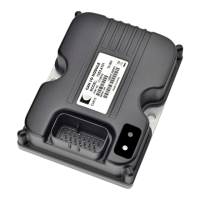3 — CANOPEN COMMUNICATIONS
Curtis 1353 CANopen Expansion Module Manual – June 2017 Return to TOC
pg. 16
If the master sends a Stop NMT command or the 1353 detects an internal fault, the 1353 will go to the
Stopped state. In the Stopped state the 1353 will listen for NMTs and produce its heartbeat message
only. PDOs and SDOs (including any timeouts) are ignored.
At any point, if the master sends a Reset Communication or Reset Module (warm boot), the 1353
will go to the Initialization state as if there were a power-cycle.
Baud Rates
e 1353 runs at one of the seven selectable baud rates: 50 kbit/s, 100 kbit/s, 125 kbit/s, 250 kbit/s,
500 kbit/s, 800 kbit/s, and 1 Mbit/s. e baud rate can be changed by a Curtis programmer or by an
SDO. Changes in the baud rate require an NMT reset or KSI cycle.
CAN Node ID
In 1353, CAN Node ID can be selected from two parameters (Node ID Low and Node ID High) and
be determined by a wired input source. e parameter of Node ID Source selects which source is
used (see table below for detail). If no source is used, set this parameter to 0.
If Node ID Source is zero, or if selected Node ID Source is non-zero and the input of this Node ID
Source is low when 1353 power on, the Node ID Low parameter will be applied as the 1353 CAN
Node ID.
If selected Node ID Source is non-zero, and the input of this Node ID Source is high when 1353
power on, the Node ID High parameter will be applied as 1353 CAN Node ID.
Node ID Source Description
0 No source input. Parameter Node ID Low is the default CAN Node ID
1 Digital input1 is used as the Node ID Source
2 Digital input2 is used as the Node ID Source
3 Digital input3 is used as the Node ID Source
4 Digital input4 is used as the Node ID Source
5 Digital input5 is used as the Node ID Source
6 Digital input6 is used as the Node ID Source
7 Digital input7 is used as the Node ID Source
8 Digital input8 is used as the Node ID Source
9 Digital input9 is used as the Node ID Source
10 Virtual digital input1 is used as the Node ID Source
11 Virtual digital input2 is used as the Node ID Source
12 Virtual digital input3 is used as the Node ID Source
13 Virtual digital input4 is used as the Node ID Source
14 Virtual digital input5 is used as the Node ID Source
15 Virtual digital input6 is used as the Node ID Source

